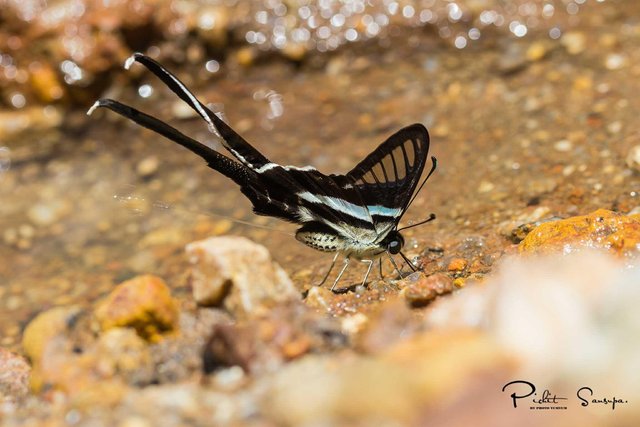Green Dragontail
Habitats
Lamproptera meges breeds in wet tropical and subtropical rainforests at altitudes between about 100-1000m. It is always found in association with rivers, streams or waterfalls.
Lifecycle
The larva feeds on Illigera ( Hernandiaceae ), and is dark green, speckled with black spots. The pupa is attached by the cremaster to the upper surface of a leaf.

Adult behaviour
Dragontails are usually encountered singly or in two's and three's. Compared to other members of the Papilionidae they have a much smaller wing area in relation to their body size, so whereas most Swallowtails and Birdwings have a very distinct fluttering flight, Dragontails are able to beat their wings much faster, and can dart from spot to spot very rapidly.
They have a very fast whirring flight, and use their long tails as a rudder - this allows them to stop in mid air and make very sudden changes of direction, They can easily be mistaken in flight for dragonflies, but tend to fly much closer to the ground. It is quite feasible that Lamproptera have evolved to become mimics of the dragonflies, and thereby avoid being attacked by them.
Males are found almost exclusively in the vicinity of running water, most commonly at waterfalls or fast-running mountain streams. They can often be seen filter-feeding - sucking up water to extract dissolved minerals, while almost continually spurting it out in a jet from the tip of the abdomen. While feeding the butterflies vibrate their wings rapidly, but the activity is interrupted with irregular momentary pauses when they are held motionless.
Both sexes can occasionally be found at rest on the foliage of bushes, with wings fully outspread.
Quote from the web
http://www.learnaboutbutterflies.com/Malaysia%20-%20Lamproptera%20meges.htm
Hi! I am a robot. I just upvoted you! I found similar content that readers might be interested in:
http://www.learnaboutbutterflies.com/Malaysia%20-%20Lamproptera%20meges.htm
Downvoting a post can decrease pending rewards and make it less visible. Common reasons:
Submit